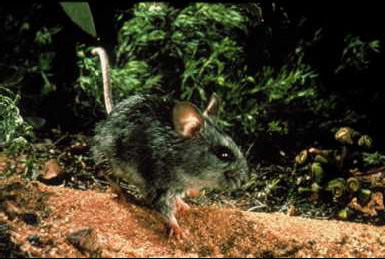Western Mouse (Pseudomys occidentalis) {!--호주서부생쥐--> Western Mouse (Walyadji)
Pseudomys occidentalis (Tate 1951)
[Photo] Babs & Bert Wells/Department of Conservation and Land Management
Size
Head and body length
85???110 (97) mm
Tail length
120???140 (129) mm
Weight
33???53 (34) g
Subspecies
None recognised.
Description
Combination of dark-grey and yellowish-buff fur with black guard hairs above and greyish-white fur below. Dark hairs on the dorsal surface of the tail. The coat is very soft and fine in texture. Paws are white. The tail can be up to 20 per cent longer than the overall body length, and is bicoloured grey above and white below. The hind feet are notably large.
Other common names
Walyadji refers to its Aboriginal name.
Distribution
Fossil remains of the western mouse have been found in limestone caves along the Western Australian coast from Jurien Bay to Margaret River, and across to the Nullarbor Plain, to the Eyre Peninsula and Kangaroo Island, South Australia.
The first western mouse was collected in 1930 at Tambellup in Western Australia and was known from only five other specimens until 1971. It has since been recorded from isolated conservation reserves within the southern Wheatbelt and south coast of Western Australia.
Habitat
The western mouse shows a preference for long unburnt habitat (between 30 and 50 yrs) on sandy clay loam or sandy loam. Vegetation in suitable habitats is variable and includes sparse low shrubland, tall dense shrubland, sparse to dense shrub mallee and mid-dense woodland. All sites where the western mouse has been collected have had patches of extremely dense vegetation. On some sites, populations occur in dense vegetation surrounded by granite rocks, which may afford them protection from fire. Quandong (Santalum acuminatum) and sedge species are thought to be important habitat requirements in the northern part of the western mouse’s range. Populations are fragmented and restricted to this type of (fragmented) habitat.
Behaviour
Largely nocturnal and semi-arboreal, the western mouse stays in a burrow during day. The burrows usually have a vertical entrance shaft connected to a loop two to three metres in diameter with a nest opposite the entrance. The burrows are about 200 to 400 millimetres deep. Radiotracking evidence suggests the species lives communally in burrows, and in captivity, several individuals will share nests during the day without fighting.
Diet
Fibrous plant material, flowers of Acacia and Hibbertia and invertebrates including beetle and moth larvae are the foods most often eaten. The western mouse will also eat seeds and fruit from other native shrubs and bushes. Quandong nuts are chewed to extract the kernels, which are rich in proteins and oils.
Breeding
Juveniles are able to breed at nine to ten months of age. Young are born from mid to late spring, becoming independent and entering the population in early summer.
Threatening processes
Subfossil records suggest that the western mouse had probably declined prior to European Settlement. Other factors that may have been, or currently are, a threat to the species include habitat destruction, changed fire regimes that remove old-growth habitat, and possibly predation by introduced predators.
Conservation status
2000 IUCN Red List of Threatened Species - Endangered
Western Australian Wildlife Conservation Act - Not Listed (Priority 4)
Environment Protection and Biodiversity Conservation - Act Not Listed
Management in Western Australia
· Monitor known populations.
· Survey areas where the western mouse was previously recorded.
· Continue feral predator control within reserves.
· Identify the impact of fire on known populations.
Other interesting facts
· Individuals are known to have travelled over 600 metres in one night from a trap site to a nesting burrow.
Selected references
Watts, C. H. S. and Aslin, H. J. (1981). The rodents of Australia. Angus and Robertson, Sydney.
Whisson, L. (1993). Endangered - Western Mouse. LANDSCOPE 8(3): 41.
Whisson, L. and Kitchener, D.J. (1995). Western Mouse. In R. Strahan (Ed.) The Mammals of Australia. Australian Museum and Reed Books. Chatswood, NSW.
Lee, A. K. (1995). The action plan for Australian rodents. Australian Nature Conservation Agency, Endangered Species Program Project Number 130.
Braithwaite, R.W., Morton, S.R., Burbidge, A.A. and Calaby, J.H. (1995). Australian names for Australian rodents. Australian Nature Conservation Agency in association with CSIRO Division of Wildlife and Ecology.
Website links
http://www.naturebase.net/projects/west_shield.html
http://www.ea.gov.au/biodiversity/threatened/action/rodents/rodap4.html#Western
